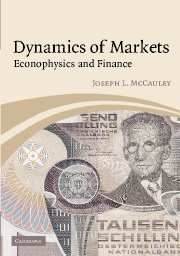Book contents
- Frontmatter
- Contents
- Preface
- 1 The moving target
- 2 Neo-classical economic theory
- 3 Probability and stochastic processes
- 4 Scaling the ivory tower of finance
- 5 Standard betting procedures in portfolio selection theory
- 6 Dynamics of financial markets, volatility, and option pricing
- 7 Thermodynamic analogies vs instability of markets
- 8 Scaling, correlations, and cascades in finance and turbulence
- 9 What is complexity?
- References
- Index
2 - Neo-classical economic theory
Published online by Cambridge University Press: 31 October 2009
- Frontmatter
- Contents
- Preface
- 1 The moving target
- 2 Neo-classical economic theory
- 3 Probability and stochastic processes
- 4 Scaling the ivory tower of finance
- 5 Standard betting procedures in portfolio selection theory
- 6 Dynamics of financial markets, volatility, and option pricing
- 7 Thermodynamic analogies vs instability of markets
- 8 Scaling, correlations, and cascades in finance and turbulence
- 9 What is complexity?
- References
- Index
Summary
Why study “optimizing behavior”?
We live in a time of widespread belief in an economic model, a model that emphasizes deregulated markets with the reduction and avoidance of government intervention in socio-economic problems. This belief gained ground explosively after the collapse of the competing extreme ideology, communism. After many decades of rigorous attempts at central planning, communism has been thoroughly discredited in our age.
The winning side now advances globalization via rapid privatization and deregulation of markets. The dominant theoretical economic underpinning for this ideology is provided by neo-classical equilibrium theory, also called optimizing behavior, and is taught in standard economics texts. Therefore it is necessary to know what are the model's assumptions and to understand how its predictions compare empirically with real, unmassaged data. We will see, among other things, that although the model is used to advise governments, businesses, and international lending agencies on financial matters, the neo-classical model relies on presumptions of stability and equilibrium in a way that completely excludes the possibility of discussing money/capital and financial markets! It is even more strange that the standard equilibrium model completely excludes the profit motive as well in describing markets: the accumulation of capital is not allowed within the confines of that model, and, because of the severe nature of the assumptions required to guarantee equilibrium, cannot be included perturbatively either. This will all be discussed below.
Economists distinguish between classical and neo-classical economic ideas. Classical theory began with Adam Smith, and neo-classical theory began with Walras, Pareto, I. Fisher and others. Adam Smith (2000) observed society qualitatively and invented the notion of an Invisible Hand that hypothetically should match supply to demand in free markets.
- Type
- Chapter
- Information
- Dynamics of MarketsEconophysics and Finance, pp. 9 - 30Publisher: Cambridge University PressPrint publication year: 2004



